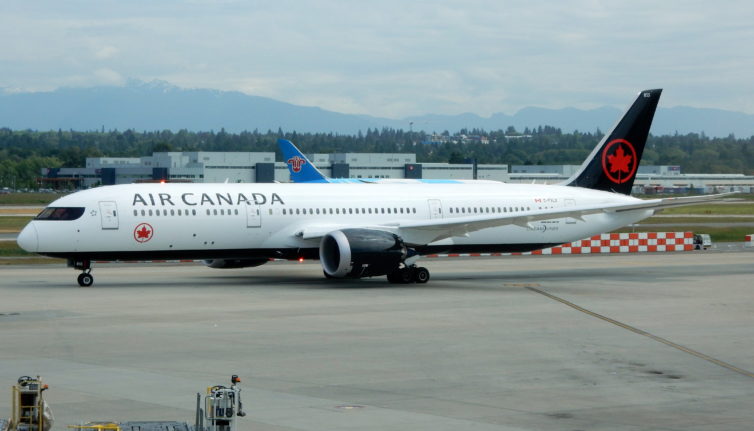
With the Dreamliner typically stuck on international duty, it’s been hard to fulfill my Dreamliner Quest. In January, on a trip to Montreal, I finally succeeded! – Photo: John Jamieson
For as long as I can remember, I’ve been fascinated by commercial aircraft. When I was a kid, I tried my best to learn everything about my two favorite jets: the Fokker F28 and the Boeing 747. Supposedly, when I was in grade one, my teacher found me on Cathay Pacific’s website trying to book a flight to Hong Kong. As I remember it, I was looking up facts about the airline’s new triple-7 fleet.
When Boeing announced plans to build the 7E7, I remember receiving a newspaper clipping from my grandmother. The article, plucked from the pages of the Vancouver Sun, described the aircraft as a “Long-Haul Gamechanger.” With its largely composite design, this aircraft was reportedly going to revolutionize fuel consumption.
Bonus: Dreamliners Going the Distance: New Ultra-Long-Haul Routes For Boeing’s 787
Despite having only flown on a few commercial aircraft (at the time), Boeing’s new jet captured my attention more than any other plane I had yet to encounter. Maybe it was the fancy name or all the marketing hype at the time… it didn’t matter! When the 787 took to the skies in 2011, I needed to fly on it. Little did I know that my Dreamliner Quest would last almost 10 years. On a recent cross-Canada trip to Montreal, I finally succeeded!
It was time to find out what I’d been missing and see if it lived up to all the hype…
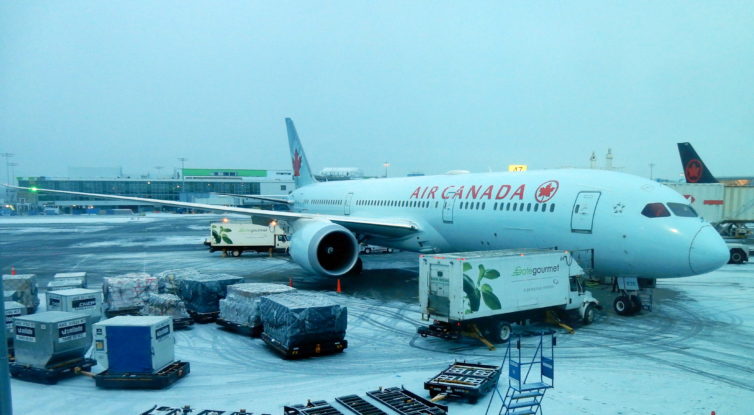
Fin 836 loading up for the five-hour flight to Montreal – Photo: John Jamieson
First 787 Dreamliner Impressions:
From the outside, the Dreamliner’s state-of-the-art design gives nothing away. While the engines are undoubtedly impressive and the cockpit noticeably modern, the windows seem ordinary. Yes, the wing-flex may catch your eye, but really, apart from aesthetics, the 787 is just another aircraft to casual observers. If it’s passenger benefits you’re craving, you’ll have to venture inside!
Bonus: Air Canada’s Signature Service Delivers – Transcontinental 777
Entering the aircraft, the Dreamliner feels like any other widebody: Spacious. That said, don’t expect to notice anything different from a 777 or 747. To be honest, the only long-haul aircraft with an interesting door feature is the 767, where the door slides up into the cabin.
As a taller person (6′-1″, 1.85m), the Dreamliner’s high ceiling definitely adds an element of comfort. However, it doesn’t really distinguish the aircraft from a 777 or A330. If you happen to be a casual “AvGeek” you probably won’t notice anything different until you reach your seat. Unfortunately, despite forming a positive impression, Air Canada’s First Class experience could not be further explored.
Bonus: Flying First Class on a British Airways 787-9 Dreamliner
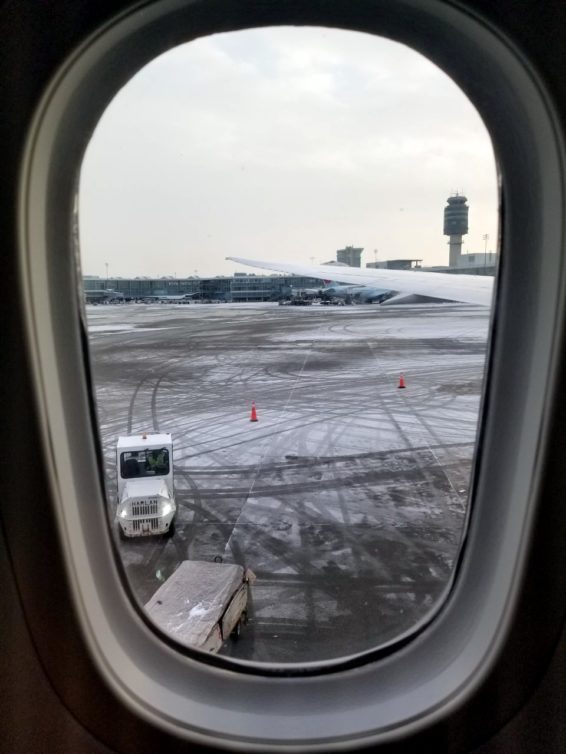
Two of the Dreamliner’s distinctive elements in one picture! – Photo: John Jamieson
Those Whopping 787 Windows
Having studied the aircraft for many years, I knew Boeing had spent extra time designing the windows. In addition to being larger, they were supposed to have this new dimming feature, the first of its kind. Being somewhat of a skeptic, I wasn’t fully convinced. How noticeable could these additions really be?
Nothing online can prepare you for the scale of the design! As soon as you sit down, the first thing you’ll notice is the size. The windows on the Dreamliner are 30 percent larger than those on a 767. While they don’t feel particularly wider, the extra height is instantly noticeable. Knowing that I would be touring Air Canada’s new Airbus A220 the following day, I made a mental note to compare the two aircraft.
My Verdict – There’s no comparison! While the windows on the A220 are undoubtedly impressive, one feature moves the needle in the Dreamliner’s favor: its Dimmable Screen. On that note…
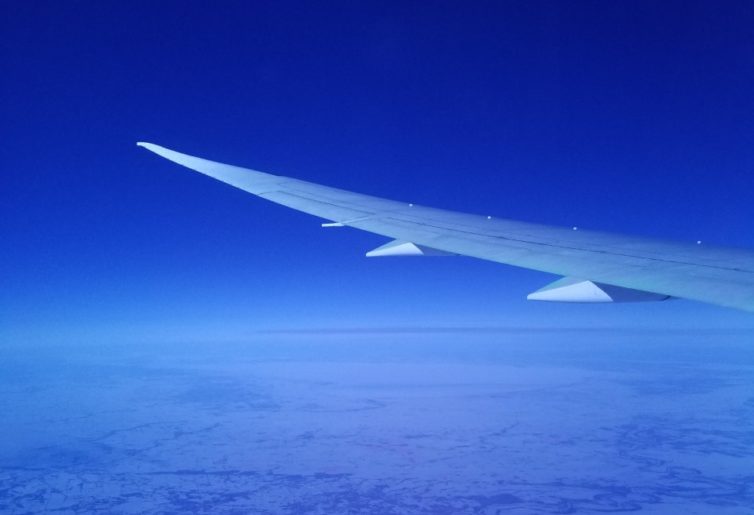
I struggled to get a good picture of the window’s darkest setting. This shade of Blue is somewhere in the middle. – Photo: John Jamieson
The Way things Work: The Dreamliner’s Dimmable Device
First of all, it’s really unusual to not have a window blind. Once you get past that oddity, things start to get really interesting!
Sandwiched between two panes of glass, the key to the system is a layer of electrically conductive gel. Taking advantage of the phenomenon known as electrochromism, the medium (gel) changes color once a voltage is applied. With the press of a button, each passenger is able to adjust the brightness of their window by varying the amount of current flowing through the gel. Working through five different shades, the passenger has a new level of control.
Throughout the flight, I experimented with the system. If you really want no light in the cabin, you can make that happen. After experimenting with each individual shade, I turned my attention to the rest of the cabin.
Cabin Comfort:
Thinking back to past reviews, I recalled that the Dreamliner had an “Anti-Jet-Lag” cabin pressure setting. People couldn’t stop raving about it. With the ability to set the cabin altitude to 6,000 feet instead of 10,000 feet, Boeing reportedly had a solution to bothersome desynchronosis!
For the five hour “Coast to Coast” flight, we’d be crossing three time zones. While Vancouver to Montreal is no Project Sunrise, the three-hour time difference is not inconsequential. Knowing that I needed to be up early the next day, I couldn’t afford a late night.
Typically, for every timezone you cross, you need an extra day at your destination to recover. I was curious (and anxious) to see if there would be an impact. Ultimately, there was nothing to worry about. After a cold pint and some food, I was able to get a reasonable sleep at our hotel. I fell asleep around 1 am (EST) and woke up on-time five and a half hours later.
Not really one for a regular sleep pattern, it was hard to determine if this was due to the cabin setting or just dumb luck. At best, the setting was a non-factor. Let me know in the comments if you’ve noticed a difference between the Dreamliner and other aircraft.
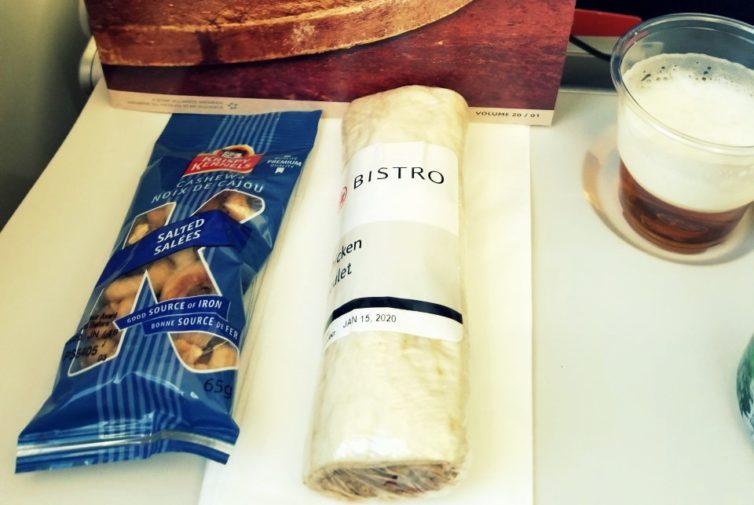
Smart branding but poor plating. From a taste point-of-view, my chicken wrap was just fine. – Photo: John Jamieson
Soft Product and IFE :
To be honest, after putting the window shade through its paces, I didn’t really investigate any more features. I’ve labeled this section “Soft Product and IFE” but really it’ll encompass the remaining elements I noted during my flights. If you’ve read my other economy reviews, you’ll know that I don’t really talk about seat pitch or recline. Never having flown in first or business class I guess I’ve just gotten used to economy legroom. Typically my seat (and flight) reviews have been dependent on whether I’ve had a row to myself.
On the flight to Montreal, I had an empty seat next to me. Thus, I was able to gain some legroom by moving my backpack under the middle seat. On the way back I wasn’t quite as fortunate. That said, I wasn’t really uncomfortable considering the length of the flight. Maybe on a 17-hour trek to Singapore or Sydney, things would be different.
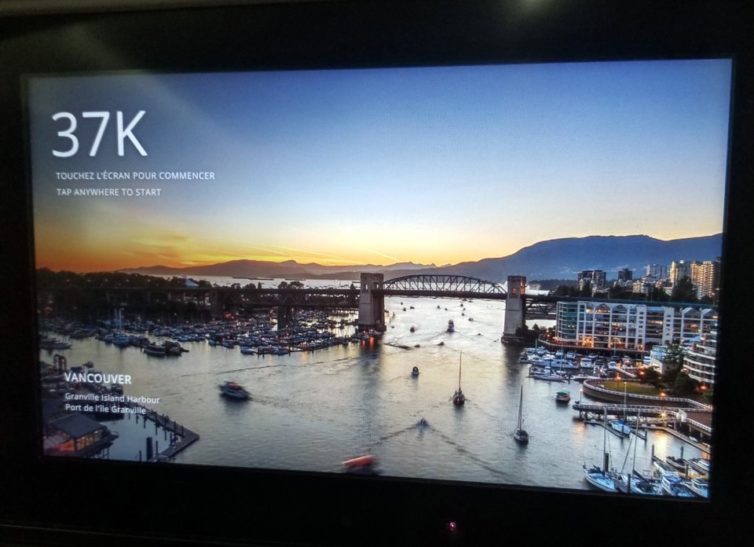
Another beautiful image of downtown Vancouver! Photos of your destination welcome you into your seat. – Photo: John Jamieson
Impressive In-Flight Entertainment
Within a few minutes, I realized that I’d seen this system before. When I flew to London in 2017 (also with Air Canada), our B777-300ER featured this updated product. Panasonic’s eX3 system, which is standard on the 787 fleet as well, is noticeably better than the Thales IFE system available on Air Canada’s older aircraft. Being able to display the moving map alongside your chosen entertainment is an awesome feature! It’s no wonder Air Canada chose to stay with Panasonic for the IFE on their new ambassador, the A220.
When paired with Air Canada’s superb content selection (I chose to watch Jumanji and The Art of Racing in the Rain), the only superior system in North America belongs to Delta.
Bonus: Can Airline In-flight Entertainment Keep Up? Should it Try?
With their long-haul fleet locked into Panasonic, the carrier will gradually reduce its reliance on the Thales system as they transition to a 737 MAX/ A220 short-haul fleet. I look forward to trying the eX1 system on an A220 someday.
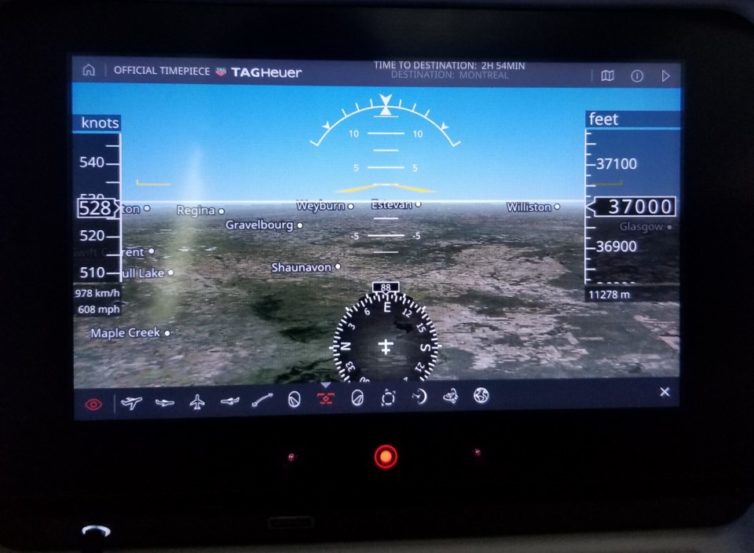
One of my favorite features from the eX3 IFE system. Put yourself in the Pilot’s seat and take in every detail! – Photo: John Jamieson
Wrap Up and Concluding Remarks
As an international widebody or a cross-country substitute, the Dreamliner is worth every penny. My seat was comfortable, the In-Flight Entertainment was outstanding, and the windows were beyond impressive! From a “Pax EX” perspective, the aircraft certainly brings it! That said, once you’ve dimmed the window and selected a film, the Dreamliner starts to feel like any other widebody; especially if you’re stuck in economy!
Additionally, while the science behind the Dreamliner’s cabin pressure setting makes sense, it’s very difficult to measure and even harder to quantify. If you’re a frequent traveler and you’ve noticed a difference, please comment below! It’s also possible that the benefits are more noticeable when you cross a certain number of timezones; I don’t know?
Bonus: Boeing is making a major change to its planes that could end jet lag as we know it – via Business Insider
With Air Canada transitioning away from medium-haul jets (in particular the Boeing 767), the Dreamliner has become more than an international ambassador. With a mix of 787-8s and 787-9,s, AC is able to right-size the aircraft for a particular market. This flexibility allows Air Canada to serve high-density North American markets without sacrificing its premium product. Even with suitable substitutes like the 737 MAX and the A220, the Dreamliner will continue to see diagcon action for Air Canada!
I hope I get the chance to fly on one again soon.
Disclosure: Air Canada covered my flights as part of an invitation to the A220 Media event in Montreal. All opinions are my own.
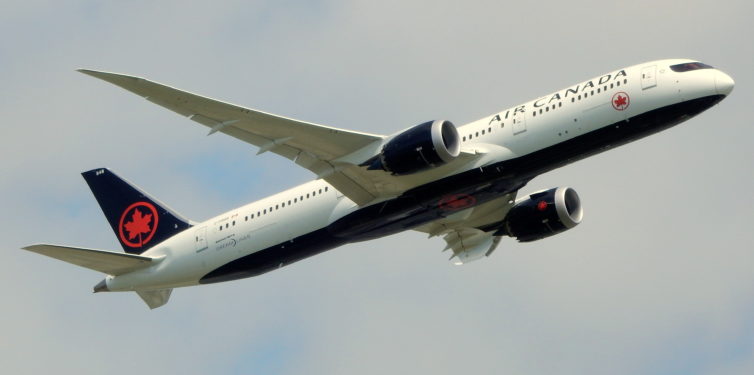
Blessed by operational benefits, with cabin comfort to boot, the Dreamliner won’t be departing Air Canada’s fleet anytime soon! – Photo: John Jamieson
Max cabin altitude on aircraft is 8,000 feet. Not 10,000′ . The maximum cabin in aircraft is normally 8.6-8.9 PSI differential. The 787 max differential is 9.43PSI on all models. Thus the lower cabin pressure altitude.
My mistake, I knew the Dreamliner’s setting was superior but I didn’t know by how much. I still think I’d have to be a regular traveler to notice a difference. Thanks for the correction!
In premium classes the Dreamliner is indeed a delight. For my money, in economy with 3-3-3 seating and very tight shoulder room, not so much. I’ll take a 2-4-2 A330 over the 787 any day if I’m in economy.
It’s funny, were this not a perfect opportunity to test out the Dreamliner, I probably would’ve looked for a 330 or 767; 2-X-2 Cabins rule!
I will say that, as much as I love the 787, I find the A350 to be a superior experience in all classes of service. It’s got all the cabin atmosphere improvements of the 787 without those pesky electronic windows (I’ve yet to find a cabin crew that doesn’t abuse their ability to control them cabin wide).
I’ve heard people complain about the master setting before; Air Canada didn’t adjust it on either of my flights, however, I could see them doing it on a summer Trans-Atlantic flight
The 767-300ER that AC use are far from being labelled as medium haul. Using the respective manufacturers’ own maximum range specs, the 767-300ER’s range is 11,070 kms, the A330 is 11,750 kms and the 787-9 is 14,140 kms and the 777-300ER is 13,649 kms.
Medium haul range is defined as being from around 1,500 kms to around 4,500 km. Clearly, the 767-300ER is NOT a medium haul aircraft. I have flown on the 767-300ER from YVR-NRT & back, YVR-KIX and back, YVR-ICN and back, YVR-FRA, YYZ-SCL and back and I would be 100% sure that none of those routes are classified as medium haul.
Yeah… I probably could’ve phrased that better; that said, traveling in Canada changes your definition of Long and Medium haul. Also, in my defense, Air Canada and Rouge still put the 767 on a couple of sub 4k routes (I.E. YYC-YUL, YYZ-YVR, YYZ-LAX) thereby using it as a “Middle of the Market” aircraft; I guess I just don’t think of it doing the 11K routes anymore.
AC doesn’t abuse their ability to control the 787’s electronic window master over-ride, they do that so most if not all can enjoy the IFE or try and catch a few zzzzz. Long before the 787s came along, they would go through the cabin and lower the shades on the windows where they could or ask the passengers to do so. It’s common sense on long haul flights.
My experience with a few long haul 787 flights (such as 5hrs LHR-TLV, 12hrs TLV-YYZ, 15hrs TLV-LAX) has been that the increased cabin pressure leads to a MAJOR improvement in the feeling of dry and tired eyes both during and after the flight.
I have head that you cannot use a GPS (Phone) on a B-787 because of the windows. Is that true?
Funny you should ask! While we were pushing back from YVR, I was hurriedly trying to post a tweet to AR’s Twitter account. While I managed to get the photos published, I was a little surprised at the delay. I didn’t think much about it at the time but it looks like this is a known phenomenon – So That”s Why My Phone Never Works On 787s! – (Ben Schlappig)/ – Hope the link helps!